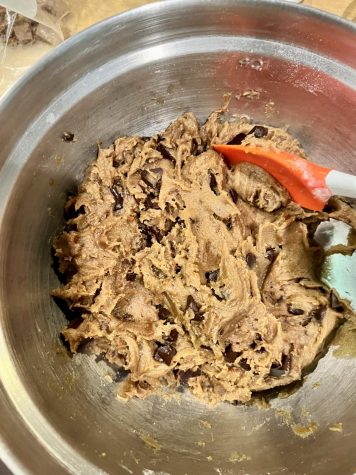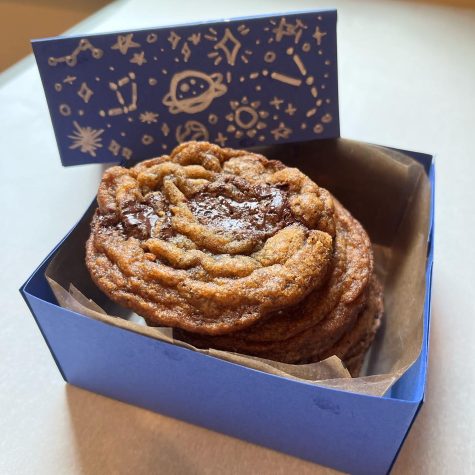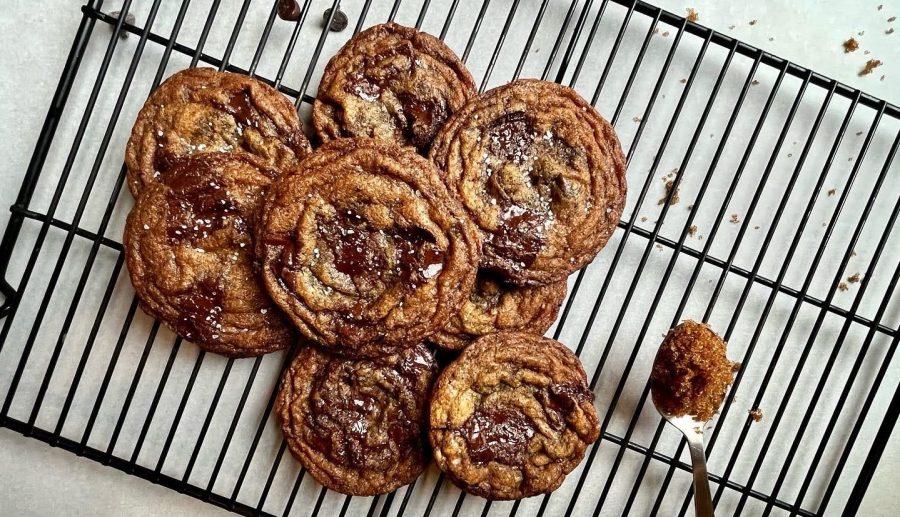Want to Bake Perfect Chocolate Chip Cookies? Here’s How!
One of the best scents in the world, in my opinion, is the smell of warm chocolate chip cookies fresh out of the oven. A symphony of browned butter, rich chocolate, heavenly vanilla…is there anything better? Well, maybe, but it’s pretty difficult to beat. As an avid self-proclaimed amateur baker, I have learned quite a bit as I have tried many recipes, with (mostly!) successes, some failures, much sweat, and (very few) tears along the way.
What better way to start your own baking journey than with a classic: chocolate chip cookies.
The quintessential chocolate chip cookie (to my preferences) has the signature wrinkled edges, a soft and chewy middle, crispy edges, an adequate amount of chocolate, and a touch of salt. The base recipe is pretty similar for all chocolate chip cookies: fat, sugar, binder, flour, leavening agent, and chocolate. The difference lies in the ratios, quality/type, and preparation.
The first essential element of a good chocolate chip cookie is fat. Most bakers like to use butter for the flavor it imparts, and its ability to be browned and whipped. Butter, or any fat, provides a cookie with some spread as it melts, and tenderness. The butter prevents the gluten formation that occurs as flour is mixed with water (often found in egg whites), resulting in a more tender product. Based on the ratio of butter to the other ingredients, the cookie’s tenderness will vary. While there are other fat alternatives, like shortening, they have different properties and characteristics that may affect the structure of the batch.
Butter is typically creamed with sugar, as the sugar granules create air pockets in the butter and partially dissolve in the process. This is especially essential to more structured desserts, like cakes. Another option to incorporate butter into the dough is melting, a method that generally creates denser cookies with less height.
Browning butter is something I have started to do more recently, and I can definitely taste a difference in the flavor of my baked goods. This process evaporates much of the moisture in the butter and leaves a lingering nutty, caramel flavor. Another *fancy* trick to add more depth of flavor to your chocolate chip cookies is a little espresso powder- it doesn’t leave a strong coffee taste, but rather intensifies the chocolate flavor. The same rationale is true for adding vanilla to many baked goods, including chocolate chip cookies- it’s all about the flavor intensification!
The second important ingredient to a good chocolate chip cookie is sugar. The caramelization of sugar creates some of the thin, crispy edges of a cookie. As the cookie cools, the sugar also settles into an almost toffee-like flavor. In chocolate chip cookies, using a mix of brown and white granulated sugars is often preferred because the white sugar helps with spread, while the brown sugar creates a more chewy texture, particularly in the middle of the cookie.
Brown sugar is essentially white sugar that has been mixed with molasses, and ranges from light to dark brown. It is slightly acidic, unlike white sugar, and thus reacts with baking soda to leaven the cookie. Granulated white sugar adds crispness to the cookie, so a mixture of both sugars gives both properties to the cookie. To me, brown sugar also gives chocolate chip cookies its signature flavor, so making them without seems wrong.
Binders are ingredients that literally bind the dough together, typically eggs. The whites of eggs contain water and protein, and thus can trap and retain air bubbles to create water vapor. This also adds volume and rise to baked goods. The yolks are mostly fat, giving cookies more tenderness. Typically, eggs and other wet ingredients are mixed together before combining with the dry ingredients, allowing for more homogeneity in the dough.
The baking aisle at grocery stores can be overwhelming, with the many varieties of flours available: all-purpose (AP), gluten-free, rice, almond, bread, and cake flours to name a few common types. The difference between these flours is the source from which they are made, and protein content. Bread flour has a higher protein content, giving cookies more chew, while all-purpose- like its namesake- is used in most recipes. While some recipes call for a mix of the two flours, I tend to stick with all-purpose since it is usually what I have on hand, and the results have been good!
In terms of leavening agents, there are three major ones used by bakers: baking soda, baking powder, and yeast. Yeast is a natural fungus that creates carbon dioxide through fermentation, and is mostly used for breads. Baking soda and powder are more often used in desserts.

Photos by Hannah Choy
Baking soda, or sodium bicarbonate, when combined with an acid and dissolved in a liquid, dissociates into sodium, water, and carbon dioxide. This gives baked goods less rise than baking powder, but promotes browning. On the other hand, baking powder is a mixture of baking soda and powdered acids, so it doesn’t require an acid to react like baking soda. Instead, this agent reacts twice, once when combined with liquid, and the second time after being heated. This gives foods like cake a more fluffy, aerated texture. Either can be used for chocolate chip cookies depending on your preferences, but I like to use solely baking soda in my cookies.
Lastly, the star of a good chocolate chip cookie- the chocolate. There are many options you can choose, but my favorite combination thus far is a mix of semi-sweet baking chocolate and chocolate chips. Chocolate chips have a coating on the outside that prevents them from melting in the same way chocolate chunks can, creating a lack of pools of chocolate in your cookies. Look for products labeled “baking chocolate” or opt for chocolate bars- not candy chocolate- for best results. Using bars also creates variability in the size of the chocolate shards, since you will have to chop them up, creating organic shapes and more pockets of chocolate in the cookies.
Other background notes I love in a good chocolate chip cookie are a quality vanilla (usually vanilla extract) and a touch of salt for balance. Refrigerating your cookie dough after making it is also a good practice, as it prevents the dough from spreading out too much when baking, and gives the cookies more structure. Resting the dough also gives the different elements time to develop and meld together, providing a superior end product.
I have tried the viral 48-Hour Chocolate Chip Cookie recipe, and after baking off a cookie every 12 hours throughout the process, I concluded that past 24 hours, I didn’t notice a significant difference in the flavor. Additionally, I found the inclusion of homemade toffee (while delicious) to be overpowering, and probably not something I will do in the future.
In the end, it’s up to you on which recipe, methods, and ingredients you choose to use to bake up a batch of chocolate chip cookies. No matter what combination is used, the result will probably be delicious! However, I hope that this provides some insight into the reasoning for the common processes and ingredients that are employed when making chocolate chip cookies, as well as something you might want to try when making a future batch of cookies.

For additional information, check out these sources:
https://www.seriouseats.com/the-food-lab-best-chocolate-chip-cookie-recipe
https://tasty.co/recipe/the-best-chewy-chocolate-chip-cookies
Your donation will support the student journalists of Chamblee High School Blue & Gold. Your contribution will allow us to print editions of our work and cover our annual website hosting costs. Currently, we are working to fund a Halloween satire edition.

Hannah Choy (‘24) is a senior and editor of the Blue & Gold. In five years, she hopes to be happy wherever life has taken her, and is doing things she is passionate about. Her three favorite things are matcha, baking for loved ones, and Spotify friend activity!










Elizabeth Avett • Sep 8, 2022 at 8:46 pm
What a lucky friend you have!!🤗